

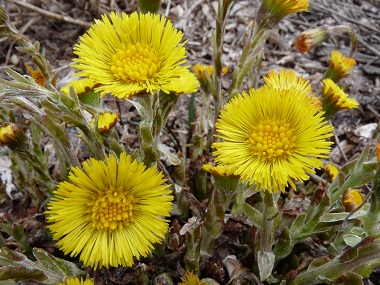
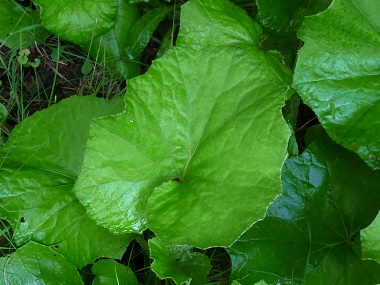
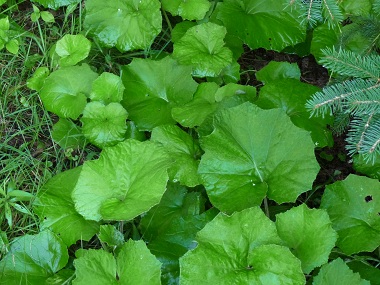

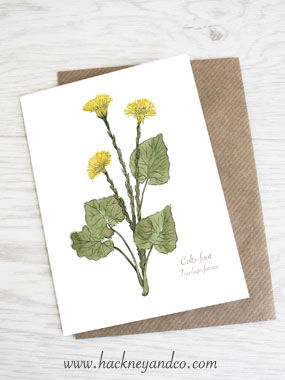
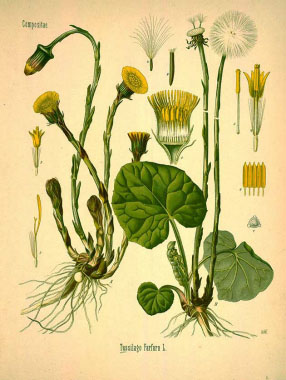
To support our efforts please browse our store (books with health benefits, etc.).
Coltsfoot is a perennial plant that looks similar to a dandelion when it blooms in spring. This wild edible plant is unusual in that the flowers bloom and die before the appearance of any leaves, which earned Coltsfoot the name of "son before the father" in earlier times. Before the introduction of matches, the felt-like covering of the plant, wrapped in a rag and dipped in a solution of saltpetre, was considered to be excellent tinder after being dried in the sun. This plant contains mucilage, bitter glycosides, and tannins; it is these that are thought to give the herb anti-inflammatory and antitussive (cough prevention and treatment) properties. Coltsfoot root contains pyrrolizidine alkaloids, potentially toxic constituents and it suspected that there may be small quantities in the leaves.
Distinguishing Features
The bright yellow flowers appear early in the spring, prior to the emergence of any leaves. The top of the leaf surface is smooth and almost waxy in appearance, while the underside is covered with white, wool-like hairs. In Southern Ontario, coltsfoot flowers in April, often before the last of the snow melts. Flower heads have even been known to push through snow.
Flowers
Coltsfoot flowers are single, measuring about 1.5 cm (0.6 in.) across surrounded by involucral bracts. Flowers are bright yellow, have ray-florets with tongue-like pistillate flowers in many rows. It has five stamens. This flower is typically the first flower to appear in spring and withers away when the leaves appear. Some people confuse these flowers with dandelion flowers.
 Fields
of Nutrition has medicinal benefits and vitamin/mineral content of Coltsfoot.
Fields
of Nutrition has medicinal benefits and vitamin/mineral content of Coltsfoot.
Leaves
The top ‘hoof-shaped’ (colt’s foot-shaped or heart-shaped) leaf surface is smooth and almost waxy in appearance, while the underside is covered with white, wool-like hairs. They can grow from 5 to 25 cm long, and are basal.
Height
Average height is between 10 and 15 cm.
Habitat
Coltsfoot is found in open, disturbed areas. It often grows in ditches, along roadsides, on forest edges and on steep slopes prone to landslides. It tolerates wet, poorly drained areas and riverbanks susceptible to spring flooding.
Edible Parts
Very small quantities of fresh young leaves can be used in salads. Leaves are most recognized as being used for treating respiratory disorders (for example colds, bronchitis, cough and allergic asthma attacks). According to many herbalists, coltsfoot leaves and flowers are recommended in the form of syrup or infusions to soothe the mentioned respiratory disorders. Never ingest or use this plant without proper consultation with a qualified health professional.
Other Name
Coughwort.
Similar Plants
Butterbur.
Recipes
Winter Survival Food Handbook

PDF Plant Magazines
Types of Wild Food
Geographic Zones Seasons
Disclaimer
EdibleWildFood.com is informational in nature. While we strive to be 100% accurate, it is solely up to the reader to ensure proper plant identification. Some wild plants are poisonous or can have serious adverse health effects.
We are not health professionals, medical doctors, nor are we nutritionists. It is up to the reader to verify nutritional information and health benefits with qualified professionals for all edible plants listed in this web site. Please click here for more information.
Why Edible Wild Food?
- Food costs are rising
- Free, wild food is readily abundant
- Wild food adds nutrition to your diet
- Wild food can help treat various medical conditions





